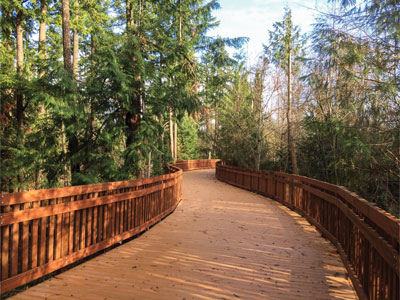With inclusion front of mind for many park and recreation professionals these days, new strategies are arising for creating more diverse experiences in parks and natural areas. While paths and trails can provide a respite from the busy world and help people connect with nature, you can take this mission even further by creating a sensory trail.
Sensory trails provide a series of experiences along a route that engage all of the senses. They can be found in a variety of outdoor settings, from parks to school grounds and beyond.
While they are often planned for people with disabilities—especially those with sensory impairments such as vision or hearing loss—sensory trails encourage people of all ages and abilities to use all of their senses. You can bring the environment surrounding your trail to life through sensory experiences such as the scent of pine needles, the texture of bark or the sound of water tumbling over rocks.
hearing loss—sensory trails encourage people of all ages and abilities to use all of their senses. You can bring the environment surrounding your trail to life through sensory experiences such as the scent of pine needles, the texture of bark or the sound of water tumbling over rocks.
Sensory trails provide a deeper, closer experience of nature as they encourage visitors to experience your site using all of their senses. They can help educate visitors about nature while encouraging them to be active.
Because they are so often designed to be fully inclusive experiences, you should carefully consider the surface of your sensory trail. Dirt and grass paths can be difficult for those using mobility devices to navigate, and uneven trails can create trip hazards for older visitors or those with less coordination.
Consider creating a boardwalk to help guide visitors through your sensory trail experience. Boardwalks made from recycled plastic lumber can withstand harsh weather conditions and require virtually no maintenance, while creating a comfortable, accessible way to navigate your trail.
Furthermore, using recycled lumber prevents deforestation and helps reinforce the environmental message of your park and trail. With an estimated lifecycle of 20 years in a commercial installation, recycled plastic lumber provides a long-lasting solution that offers the aesthetic of wood without the danger of rot, deterioration or splintering.
You can take your use of recycled materials a step further by incorporating signage made from recycled plastic into your sensory trail. Recycled plastic signage can help direct visitors to the various experiences along the trail, while educating them about the nature that surrounds them.
For More Information
Tangent Materials
630-264-1110
www.tangentmaterials.com


